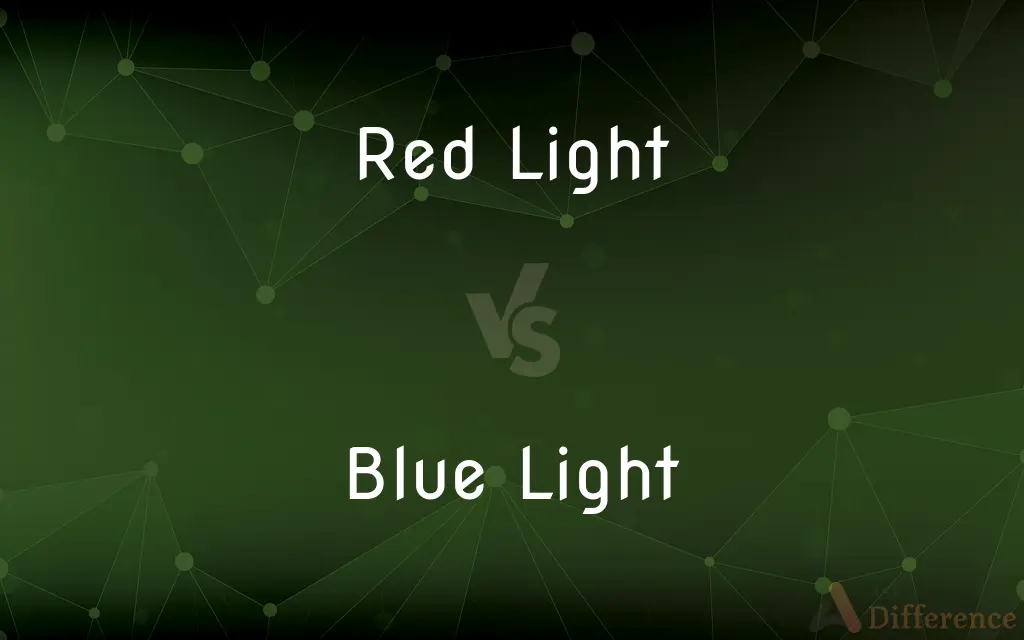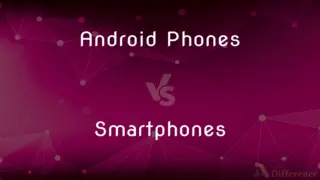Red Light vs. Blue Light — What's the Difference?
By Maham Liaqat & Fiza Rafique — Published on November 24, 2024
Red light, with longer wavelengths, promotes relaxation and sleep, while blue light, with shorter wavelengths, boosts alertness and can disrupt sleep patterns.

Difference Between Red Light and Blue Light
Table of Contents
ADVERTISEMENT
Key Differences
Red light operates at the longer-wavelength end of the visible spectrum, known for its calming effects and ability to promote sleep by influencing melatonin production. On the other hand, blue light sits at the shorter-wavelength side, known for enhancing alertness and inhibiting melatonin production, which can disrupt sleep cycles.
Red light is commonly used in therapy for its healing properties, such as improving skin conditions and reducing pain. Whereas blue light is utilized in devices like computers and smartphones, which can lead to eye strain and sleep issues if used excessively at night.
In terms of energy efficiency, red light sources like LEDs are often more energy-efficient and have a longer lifespan. Blue light sources, while also efficient, can contribute to digital eye strain and have implications for long-term vision health.
Red light's wavelength allows for deeper penetration into the skin, which is why it's used in phototherapy treatments for skin and muscle recovery. Blue light, conversely, primarily affects the surface of the eye and skin, leading to concerns about its impact on eye health and circadian rhythms.
Despite their differences, both red and blue lights are essential in various technologies and medical therapies, highlighting the importance of understanding and managing exposure to both light types for optimal health and wellbeing.
ADVERTISEMENT
Comparison Chart
Wavelength
Longer, around 620-750 nm
Shorter, around 450-495 nm
Effects on Sleep
Promotes relaxation and sleep
Boosts alertness, can disrupt sleep patterns
Therapeutic Uses
Skin conditions, pain relief
Treats SAD, regulates circadian rhythm
Energy Efficiency
Higher, with longer lifespan
Efficient, but can cause digital eye strain
Health Implications
Beneficial for skin and muscle recovery
Potential for eye strain and sleep disruption
Compare with Definitions
Red Light
Known for energy efficiency in LED lighting.
Red LEDs are chosen for their energy-saving benefits.
Blue Light
Used in light therapy to treat Seasonal Affective Disorder (SAD).
Blue light therapy is effective for those suffering from SAD.
Red Light
Used in night vision equipment without disrupting dark adaptation.
Red light is used in night vision to prevent blinding.
Blue Light
Linked to higher energy levels and alertness during the day.
Blue light exposure during the day can boost mood and alertness.
Red Light
Has longer wavelengths that penetrate deep into the skin.
Red light penetrates deeper into the skin to promote healing.
Blue Light
Has shorter wavelengths that can affect the circadian rhythm.
Blue light exposure can alter your internal body clock.
Red Light
Promotes sleep by influencing melatonin production.
Using red light at night can help improve sleep quality.
Blue Light
Found in digital screens, contributing to eye strain.
Excessive exposure to blue light from screens can lead to eye fatigue.
Red Light
Used in phototherapy to improve skin health.
Red light therapy is popular for its anti-aging benefits.
Blue Light
Can disrupt sleep patterns by inhibiting melatonin.
Avoiding blue light at night can help maintain natural sleep cycles.
Common Curiosities
Can red light therapy penetrate deep into the skin?
Yes, red light's longer wavelengths allow it to penetrate deeper into the skin, aiding in healing and recovery.
Are red and blue lights energy efficient?
Both red and blue lights, especially LEDs, are energy efficient, but red light sources tend to have a longer lifespan.
What is red light used for?
Red light is used for therapeutic purposes, such as skin treatment and pain relief, and promotes sleep.
Is blue light harmful to the eyes?
Prolonged exposure to blue light can lead to digital eye strain and may affect long-term vision health.
How does red light affect melatonin production?
Red light can promote melatonin production, enhancing sleep quality and relaxation.
How does blue light affect sleep?
Blue light inhibits melatonin production, potentially disrupting sleep patterns and making it harder to fall asleep.
Are there specific times when blue light exposure should be minimized?
Minimizing blue light exposure in the evening can help maintain natural sleep cycles and prevent sleep disturbances.
Can altering light exposure improve sleep quality?
Yes, reducing blue light exposure in the evening and using red light can improve sleep quality by supporting natural sleep-wake cycles.
Can blue light therapy treat depression?
Yes, blue light therapy is used to treat Seasonal Affective Disorder (SAD) and can help regulate mood.
Are there any long-term effects of blue light exposure?
Long-term excessive exposure to blue light may increase the risk of digital eye strain and potentially affect vision health.
What are the benefits of red light LEDs?
Red light LEDs are energy-efficient and have therapeutic benefits, including skin health improvement and pain relief.
How does blue light impact circadian rhythms?
Blue light exposure can alter circadian rhythms, affecting sleep and wakefulness patterns.
Can both red and blue lights be used in therapy?
Yes, both are used in different therapeutic contexts: red for physical healing and relaxation, blue for mood regulation and circadian rhythm adjustment.
Does red light have any impact on eye health?
Red light is generally considered safe for the eyes, especially compared to blue light, and does not contribute to digital eye strain.
Why is avoiding blue light at night recommended?
Avoiding blue light at night helps prevent sleep disruption by allowing natural melatonin production.
Share Your Discovery

Previous Comparison
Android Phones vs. Smartphones
Next Comparison
Australian States vs. Australian TerritoriesAuthor Spotlight
Written by
Maham LiaqatCo-written by
Fiza RafiqueFiza Rafique is a skilled content writer at AskDifference.com, where she meticulously refines and enhances written pieces. Drawing from her vast editorial expertise, Fiza ensures clarity, accuracy, and precision in every article. Passionate about language, she continually seeks to elevate the quality of content for readers worldwide.















































